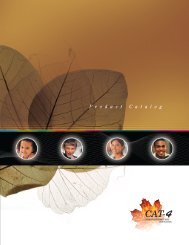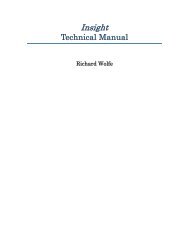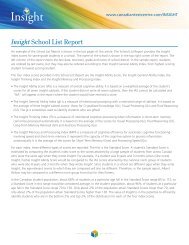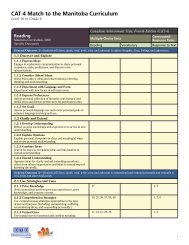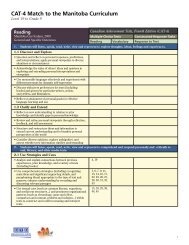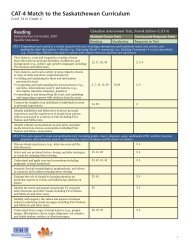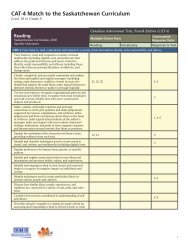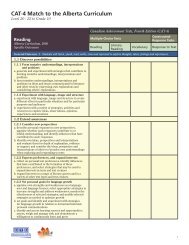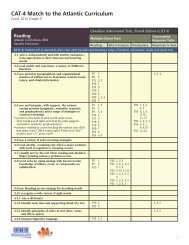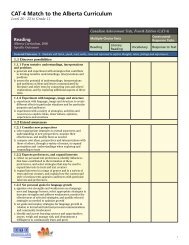Grade 4 - Canadian Test Centre
Grade 4 - Canadian Test Centre
Grade 4 - Canadian Test Centre
Create successful ePaper yourself
Turn your PDF publications into a flip-book with our unique Google optimized e-Paper software.
CAT∙4 Match to the British Columbia Curriculum<br />
Level 14 to <strong>Grade</strong> 4<br />
Mathematics<br />
British Columbia<br />
Curriculum, 2009<br />
Specific Expectations<br />
Number<br />
<strong>Canadian</strong> Achievement <strong>Test</strong>s, Fourth Edition (CAT·4)<br />
Multiple-Choice <strong>Test</strong>s<br />
Mathematics<br />
Computation<br />
and Estimation<br />
Constructed-Response Tasks<br />
Math Processes<br />
A1 represent and describe whole numbers to 10 000,<br />
pictorially and symbolically<br />
A2 compare and order numbers to 10 000 51<br />
A3 demonstrate an understanding of addition of numbers<br />
with answers to 10 000 and their corresponding<br />
subtractions (limited to 3 and 4-digit numerals) by using<br />
personal strategies for adding and subtracting estimating<br />
sums and differences solving problems involving<br />
addition and subtraction<br />
A4 explain the properties of 0 and 1 for multiplication, and<br />
the property of 1 for division [C, CN, R]<br />
A4 explain the properties of 0 and 1 for multiplication, and<br />
the property of 1 for division [C, CN, R]<br />
A5 describe and apply mental mathematics strategies, such<br />
as<br />
• skip counting from a known fact<br />
• using doubling or halving<br />
• using doubling or halving and adding or subtracting one<br />
more group<br />
• using patterns in the 9s facts using repeated doubling to<br />
determine basic multiplication facts to and related division<br />
facts<br />
A6 demonstrate an understanding of multiplication (2- or<br />
3-digit by 1-digit) to solve problems by<br />
• using personal strategies for multiplication with and<br />
without concrete materials<br />
• using arrays to represent multiplication<br />
• connecting concrete representations to symbolic<br />
representations<br />
• estimating products<br />
A7 demonstrate an understanding of division (1-digit divisor<br />
and up to 2-digit dividend) to solve problems by<br />
• using personal strategies for dividing with and without<br />
concrete materials<br />
• estimating quotients<br />
• relating division to multiplication<br />
A8 demonstrate an understanding of fractions less<br />
than or equal to one by using concrete and pictorial<br />
representations to<br />
• name and record fractions for the parts of a whole or a set<br />
• compare and order fractions<br />
• model and explain that for different wholes, two identical<br />
fractions may not represent the same quantity<br />
• provide examples of where fractions are used<br />
A9 describe and represent decimals (tenths and<br />
hundredths) concretely, pictorially, and symbolically<br />
19, 58<br />
1, 3, 4, 5, 6, 7, 8,<br />
11, 13, 14, 19,<br />
22, 29<br />
1, 36 2, 9, 10, 12, 15,<br />
17, 20, 23, 30,<br />
34, 35<br />
37, 59 21, 26, 27, 31, 32,<br />
33, 36<br />
22, 24, 32<br />
6



